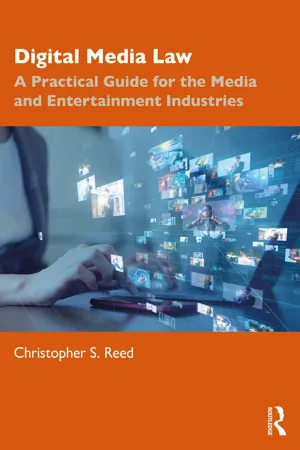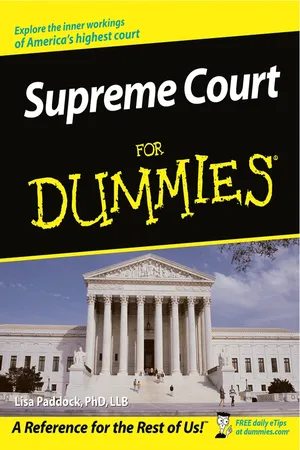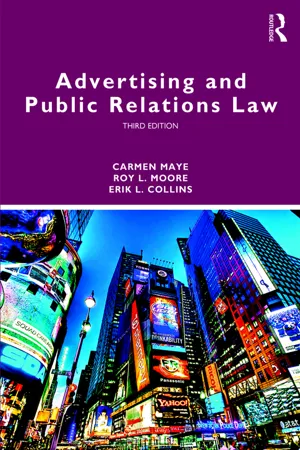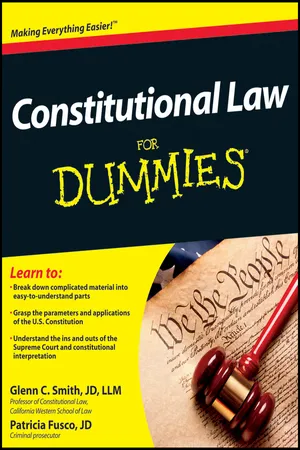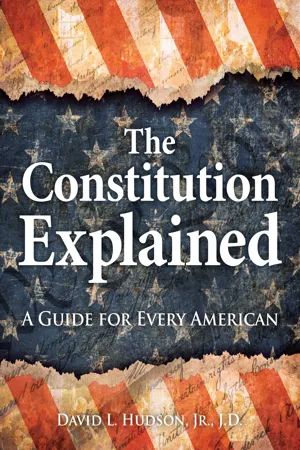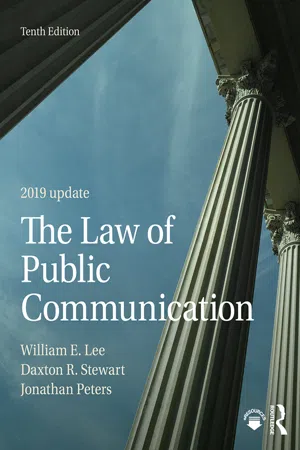Politics & International Relations
First Amendment
The First Amendment to the United States Constitution protects freedom of speech, religion, and the press, as well as the right to assemble and petition the government. It is a cornerstone of American democracy, ensuring that individuals can express their opinions, beliefs, and grievances without fear of government censorship or reprisal. The First Amendment has been the subject of numerous legal interpretations and debates, shaping the country's approach to free expression.
Written by Perlego with AI-assistance
Related key terms
Related key terms
1 of 4
Related key terms
1 of 3
11 Key excerpts on "First Amendment"
- eBook - ePub
Digital Media Law
A Practical Guide for the Media and Entertainment Industries
- Christopher S. Reed(Author)
- 2022(Publication Date)
- Routledge(Publisher)
Chapter 3 The First Amendment
DOI: 10.4324/9781003197966-3What is the First Amendment and what rights does it afford citizens? Does it provide special guarantees to the press? What are the boundaries of the First Amendment and how do courts resolve tensions between First Amendment rights and other important constitutional values?In the previous chapter, we established the broad contours of the law. In this chapter, we will orient ourselves within that broad universe by examining the spectrum of protection that First Amendment law has developed over the years and how it affects the media industry. Among other things, this chapter will examine distinctions between highly protected speech, such as political statements, and unprotected speech, such as obscenity.Fundamental Freedoms
The First Amendment to the U.S. Constitution provides that:Congress shall make no law respecting an establishment of religion, or prohibiting the free exercise thereof; or abridging the freedom of speech, or of the press; or the right of the people peaceably to assemble, and to petition the government for a redress of grievances.In that single sentence, comprising only 45 words, the framers of the Constitution established a framework for what have become some of the most sacrosanct rights of U.S. citizens: the right to freely practice religious beliefs and be free from government attempts at establishing a national religion; the right to assemble peaceably, which enables the protests, demonstrations, and marches that have, throughout our history, led to momentous legal and cultural changes; the right to complain to the government and ask for changes to laws and policies; and the freedom to speak openly and freely, and the right of the press to report on government affairs and other matters of public importance.The rights set forth in the First Amendment represent the framers’ attempt at avoiding the tyranny of a central government, such as the English monarchy from which they had fled. As noted previously, the guiding principle of the U.S. democratic framework is that power vests first in the people, who grant the authority to govern to the government. The ability to speak, assemble, and practice one’s own religious beliefs free from undue government involvement, coupled with the right to complain to (and seek redress from) the government, were all considered essential to ensuring that the power to govern remained fundamentally with the citizens. - eBook - ePub
The History of Media and Communication
The First Amendment, Democracy, and the Media
- Laura Stein(Author)
- 2010(Publication Date)
- University of Illinois Press(Publisher)
The path to this future will be marked by discord. The First Amendment is a site where both competing definitions of speech rights and competing understandings of democracy itself do battle. This book locates the source of these clashes in liberal-democratic theory and considers the implications of divergent views of speech rights on communication law and policy and on the prospects for democratic communication in contemporary media. In the process, it contemplates the interrelationships among the political philosophical roots of First Amendment thought, contemporary legal constructions of speech rights, and the opportunities that people have to participate in democratic communication.Speech Rights in FluxThe notion of an indeterminate and contestable First Amendment is unimaginable to many Americans. In the American popular consciousness, the First Amendment stands as an unassailable bulwark of individual freedom: unwavering, permanent, and solid. Yet, on closer inspection, the popular view falters. For the first hundred years of its existence, the First Amendment did little to protect speech rights. The amendment did not prevent some of America’s founding fathers from enacting laws against speech that criticized government officials (the Sedition Act of 1798). Nor did it inhibit the city of Boston from denying a black minister the right to speak against racism in a public park (Davis v. Massachusetts, 1897). Indeed, history shows that for more than a hundred years after its enactment, the First Amendment failed to protect political dissent or the right to speak on public property. The belief that U.S. citizens have always had strong speech-rights protections is a modern myth.Contemporary First Amendment law took shape primarily over two periods in recent U.S. history. First, in the decades between World War I and World War II free-speech law underwent a profound transformation. Events of the era, including the Great Depression, the New Deal, and the rise of the labor and progressive movements, precipitated a change in legal thinking on constitutional law (Kairys 257; Tribe 448–50). The Court became increasingly willing to uphold legislative interventions designed to alleviate the shortcomings of U.S. social, political, and economic life. The development of the rights to speak, to assemble, and to distribute literature on public property corresponded with the free-speech campaigns of labor and progressive activists who saw speech rights as an integral aspect of political organizing (Kairys 238, 246).1 A Supreme Court decision to affirm the right to speak in public places stood at the pinnacle of this period of development. In Hague v. CIO - eBook - ePub
- Lisa Paddock(Author)
- 2011(Publication Date)
- For Dummies(Publisher)
Chapter 8 The First Amendment Is the First Amendment In This Chapter Deconstructing the First Amendment Connecting freedom of religion with freedom of expression Tracing the evolution of the right to privacy Understanding how freedom of speech and press ensures democracy Exploring two lesser known First Amendment rights T he founding fathers based the nation on a document that includes not only seven articles, but ten amendments. The first of these amendments addresses some of the considerations that were uppermost in their minds. It continues to be one of the most distinctive symbols of American culture and — not coincidentally — one of the most fertile areas for litigation in society. Understanding Freedom of Religion The First Amendment opens with these words: “Congress shall make no law respecting an establishment of religion, or prohibiting the free exercise thereof.” Freedom of religion in America has always consisted of these two strands: the prohibition against government establishment or endorsement of religion, and the prohibition against government interference with religious practices. That said, it must be noted that until well into the twentieth century, freedom of religion was simply not an issue for most Americans, and litigation on the subject was almost nil. Many Americans’ forebears — starting with those who came over on the Mayflower — came to these shores seeking freedom from religious persecution. When the framers of the Constitution failed to address ongoing concerns about this and other individual rights in the body of that document, some of the states declined to sign up immediately. The framers believed that the three articles of the Constitution contained sufficient safeguards to prevent the federal government from interfering in peoples’ lives. In addition, the individual states had their own bills of rights - eBook - ePub
American Constitutional Law 8E, 2-VOL SET
2-VOLUME SET
- Ralph A. Rossum(Author)
- 0(Publication Date)
- Routledge(Publisher)
5Freedom of Speech, Press, and AssociationDOI: 10.4324/9780429037191-17- The Meaning of the First Amendment
- First Amendment Standards
- Gitlow v. New York (1925)
- Schenck v. United States (1919)
- Dennis v. United States (1951)
- Barenblatt v. United States (1959)
- Brandenburg v. Ohio (1969)
- Political Expression
- McConnell v. Federal Election Commission (2003)
- The Regulation of Speech
- Boy Scouts of America v. Dale (2000)
- Texas v. Johnson (1989)
- R.A.V. v. City of St. Paul (1992)
- Hill v. Colorado (2000)
- Restraints on the Press
- Near v. Minnesota (1931)
- New York Times Company v. United States (1971)
- Branzburg v. Hayes (1972)
- Memorandum Opinion and Order, Federal Communications Commission (1987)
- Libel and Invasion of Privacy
- New York Times v. Sullivan (1964)
- Obscenity
- Miller v. California/Paris Adult Theater I v. Slaton (1973)
- Reno v. American Civil Liberties Union (1997)
- Indianapolis Anti-Pornography Ordinance (1984)
- Conclusions
- Notes
- Selected Reading
- Cases
The First Amendment speaks in strikingly absolute terms: "Congress shall make no law . . . abridging the freedom of speech, or of the press." The Supreme Court's interpretation of these guarantees has been both broader and narrower than a literal reading of the amendment might suggest. The Court has ruled that the amendment protects channels of communication other than speech and press, including those such as television and the Internet invented since the amendment's adoption. It has also extended some protection to actions undertaken with communicative intent such as political demonstrations and symbolic acts, even if they do not involve speech. Acknowledging that "effective advocacy of both public and private points of view, particularly controversial ones, is undeniably enhanced by group association," the Court has recognized a First Amendment right to freedom of association for expressive purposes.1 Most importantly, in Gitlow v. New York (1925) and Near v. Minnesota - eBook - ePub
The Constitution of the United States of America
Analysis and Interpretation
- (Author)
- 2006(Publication Date)
- Perlego(Publisher)
Amendment 1Congress shall make no law respecting an establishment of religion, or prohibiting the free exercise thereof; or abridging the freedom of speech, or of the press; or the right of the people peaceably to assemble, and to petition the Government for a redress of grievances.Absorption of Amendment I Into the Fourteenth AmendmentEventually the long sought protection for certain substantive personal rights was obtained by identifying them with the "liberty" which States cannot take away without due process of law. The shift in the Court's point of view was made known quite casually in Gitlow v. New York,[1] where, although affirming a conviction for violation of a State statute prohibiting the advocacy of criminal anarchy, it declared that: "For present purposes we may and do assume that freedom of speech and of the press—which are protected by the First Amendment from abridgment by Congress—are among the fundamental personal rights and 'liberties' protected by the due process clause of the Fourteenth Amendment from impairment by the States."[2] This dictum became, two years later, accepted doctrine when the Court invalidated a State law on the ground that it abridged freedom of speech contrary to the due process clause of Amendment XIV.[3] Subsequent decisions have brought the other rights safeguarded by the First Amendment, freedom of religion,[4] freedom of the press,[5] and the right of peaceable assembly,[6] - eBook - ePub
- Carmen Maye, Roy L. Moore, Erik L. Collins(Authors)
- 2019(Publication Date)
- Routledge(Publisher)
1 The First AmendmentAdvertising and public relations students and practitioners picking up a 500-plus page book filled with examples and discussions of laws regulating advertising and public relations speech could be pardoned for being somewhat puzzled. After all, the language of the First Amendment to the federal Constitution clearly mandates that “Congress [and, by logical extension, any lesser unit of government] shall make no law … abridging freedom of speech or of the press.”1 How can there be laws regulating any speech (let alone advertising or public relations speech) in the face of the Constitution’s emphatic statement that there can be “no law”? This puzzle requires us to begin with a brief overview of the First Amendment and how it is interpreted, before we turn our attention to the principal subject matter of this book.Development of First Amendment Jurisprudence
The dilemma for courts faced with deciding cases that challenge the constitutionality of attempts by government to regulate speech and press is that despite the emphatic “no law” language of the First Amendment (see Appendix A), it is almost impossible to believe that those who helped add the amendment to the federal constitution more than 200 years ago meant to protect all speech without exception, even speech, for example, that is treasonous or criminally threatening or harmful to reputation. Yet judges and justices cannot simply ignore the First Amendment because they personally disapprove of the speech in question. Therefore, they have been obliged to develop a logical, rational and defensible method of interpretation by weighing and balancing the interests of those supporting freedom of expression against those favoring competing interests. To understand how they have accomplished this, we need to take a brief look both at how judges interpret law and how historians interpret history.Role-play the part of judge for a moment. Not a Supreme Court justice but a judge in a lower level court in which the cases usually involve petty crimes and minor disagreements—the kind of court you often see depicted on afternoon or late-evening cable television programs. The next case on the docket is City v. Jones - eBook - ePub
- Glenn Smith, Patricia Fusco(Authors)
- 2011(Publication Date)
- For Dummies(Publisher)
Part IV Rights to Self-Expression and Political ParticipationIn this part . . .In making decisions, courts are constantly balancing an individual’s rights and the greater public good. The right to self-expression is no exception. In this part, we discuss how courts tackle balancing this with other interests, including how they approach the difficult area of free exercise of religion — not interfering with individual rights while at the same time not allowing the government to favor a certain religion. We also discuss politics and voting, considering what practical realities resulted from constitutional provisions and subsequent cases in these areas.Passage contains an image
Chapter 11 “Express Yourself!” Freedom of Speech In This ChapterFinding out what freedom of speech is all aboutDetermining whether the speech in question is protectedPinpointing the amount of protection speech getsLooking at situations that warrant extraordinary protectionExploring special contexts in which speech gets less protectionThe First Amendment guarantees the right of free speech. However, that doesn’t mean government can’t regulate speech to various extents. When legislatures pass laws or other governmental authorities adopt policies affecting speech, many agonizing and controversial questions arise. But luckily, a basic two-step (and, at times, three-step) approach can help you analyze many free-speech controversies.When government sets out to regulate speech, the first step is to ask whether the speech in question gets any First Amendment protection. (Some kinds of speech are considered to be unprotected — that is, outside the scope of the protections the First Amendment provides.) If the First Amendment protects the speech at issue, the second step is to ask whether government is regulating based on the content of the speech or not. In many cases, answering these two questions tells you the extent - eBook - ePub
The Constitution Explained
A Guide for Every American
- David L. Hudson(Author)
- 2022(Publication Date)
- Visible Ink Press(Publisher)
When the Warren Court ended with the retirement of Chief Justice Warren in 1969, many feared that the Court would retract or reduce constitutional freedoms, including the freedom of speech. However, in the free-speech arena, the Court under Chief Justice Warren E. Burger (1907–1995) expanded First Amendment doctrine in numerous ways. The Court narrowed several unprotected categories of speech, protecting for the first time advertising or commercial speech, and warned against the government discriminating against speech based on the content or message of the speaker. This expansion of free-speech doctrine continued even more in the subsequent decades under Courts headed by Chief Justices William H. Rehnquist and his former law clerk, John G. Roberts Jr. (1955–).In 2019, Roberts declared in an interview with Belmont University College of Law dean and former U.S. attorney general Alberto Gonzales (1955–): “I’m probably the most aggressive defender of the First Amendment. Most people might think that doesn’t quite fit with my jurisprudence in other areas.”Free-speech law is an intricate area, but there are numerous fundamental principles that can help readers navigate it.Fundamental Free-Speech Principles
1.The First Amendment protects the ability of people to criticize the government.The essence of the First Amendment is the ability of individuals to criticize the government. The Supreme Court defended this principle most notably in New York Times Co. v. Sullivan (1964), ruling that an editorial advertisement published in the New York Times that spoke of rights abuses perpetrated by Southern officials in Montgomery, Alabama, did not subject the newspaper or principal creators of the ad to liability for defamation. Montgomery police commissioner L. B. Sullivan had sued the Times and four African American clergymen who created the ad for defamation, even though he was not specifically identified.Published on March 29, 1960, in the New York Times, this ad, which was full of factual errors, resulted in a lawsuit by Police Commissioner L. B. Sullivan of Montgomery, Alabama.An all-white, state-court jury in Alabama had awarded Sullivan $500,000 in damages, a verdict upheld by the Alabama Supreme Court. The Times - eBook - ePub
No Law
Intellectual Property in the Image of an Absolute First Amendment
- David L. Lange, H. Jefferson Powell(Authors)
- 2008(Publication Date)
- Stanford Law Books(Publisher)
The [first ten] amendments were offered to curtail and restrict the general powers granted to the Executive, Legislative, and Judicial Branches two years before in the original Constitution. The Bill of Rights changed the original Constitution into a new charter under which no branch of government could abridge the people’s freedoms of press, speech, religion, and assembly. Yet the Solicitor General argues and some members of the Court appear to agree that the general powers of the Government adopted in the original Constitution should be interpreted to limit and restrict the specific and emphatic guarantees of the Bill of Rights adopted later. I can imagine no greater perversion of history. Madison and the other Framers of the First Amendment, able men that they were, wrote in language they earnestly believed could never be misunderstood: “Congress shall make no law. . . abridging the freedom. . . of the press. . . .” Both the history and language of the First Amendment support the view that the press must be left free to publish news, whatever the source, without censorship, injunctions, or prior restraints. 53 Solicitor General Griswold’s argument, in other words, turned the original history of the First Amendment upside down: instead of treating the amendment, as its language and its origins require, as a restraint on the powers granted by the original text of the Constitution, Griswold wanted the Court to use the powers granted in 1787–88 to adjust, by judicial fiat but in what the executive deemed a socially valuable fashion, the denial of power adopted in 1789–91 - eBook - ePub
- William E. Lee, Daxton R. Stewart, Jonathan Peters(Authors)
- 2019(Publication Date)
- Routledge(Publisher)
Freedom of expression includes the individual’s right to participate in symbolic forms of expression such as marching, demonstrating, contributing money to a political campaign, and even burning the American flag. Symbolic expression, which is speech melded with conduct, is not permitted in all places and at all times but is nevertheless protected by the First Amendment along with more “pure” speech and publishing. As was noted earlier, anonymous speech is also protected, lessening the chances that outcasts will be persecuted for their unpopular viewpoints.ASSOCIATING Besides the right to speak and publish, a citizen has a First Amendment right to associate with others. Alexis de Tocqueville noted that the “most natural privilege of man, next to the right of acting for himself, is that of combining his exertions with those of his fellow creatures and of acting in common with them.”142 The right of association is found in the First Amendment rights of assembly, speech, and petition. By joining a religious, political, or ideological group, individuals strengthen their individual right to speak. Thus, associations are protected from government interference not only because of the inalienable right of individuals to band together but also because associations advance political and social issues.142 Democracy in America 196 (Phillips Bradley ed., 1945). See Freedom of Association (Amy Gutman ed., 1998).Citizens have a constitutional right to band together to advocate political change,143 undertake litigation,144 or worship their God.145 Associations enjoying these rights include the conservative John Birch Society and the more liberal National Association for the Advancement of Colored People. The right of association guarantees these ideological groups the same rights enjoyed by individuals to speak, publish, pamphleteer, lobby, and march.143 Cousins v. Wigoda, 419 U.S. 477 (1975).144 NAACP v. Button, 371 U.S. 415 (1963).RECEIVING INFORMATION145 Serbian Eastern Orthodox Diocese v. Milivojevich, 426 U.S. 696 (1976). - eBook - ePub
- William O'Shaughnessy(Author)
- 2019(Publication Date)
- Whitney Media Publishing Group(Publisher)
James Madison did not have bifurcation of free speech in mind when he submitted his draft of the First Amendment. His words were clear, stark, and unadorned.Mr. Justice Oliver Wendell Holmes wrote in 1929 (United States of America v. Schwimmer ): “If there is any principle of the Constitution that more imperatively calls for attachment than any other it is the principle of free thought—not free thought for those who agree with us but freedom for the thought that we hate.”Just for a moment suppose the Brits had advised our impertinent New Rochelle neighbor Thomas Paine that he could just go right ahead and publish all his incendiary rants and ravings—but only if he also included, cheek by jowl, in the very same pamphlet, the views of the Royal Colonial Governor. I’m afraid that beguiling but flawed and dangerous invitation to Mr. Paine (or, indeed, rendered to another pesky, annoying neighbor of the day—John Peter Zenger), far from being an implementation of free speech, would have had just the opposite effect. It is surely a restriction of speech if, in order to have the privilege of expressing your own views, you have to accede to government dictums that you also have to root around and drag up someone arguing an opposing view.At its heart, the First Amendment is another of the checking mechanisms the Founders so intelligently promulgated to ensure that our worst instincts would be tempered by our better values. And speaking of “checking mechanisms”—should the government take on that mantle, we’ve got a real problem.Despite the mounting evidence of the harm it causes, political correctness in our nation has so far escaped the opprobrium it deserves. Far from being the language of the enlightened, political correctness is the lingua franca
Index pages curate the most relevant extracts from our library of academic textbooks. They’ve been created using an in-house natural language model (NLM), each adding context and meaning to key research topics.
Explore more topic indexes
Explore more topic indexes
1 of 6
Explore more topic indexes
1 of 4
